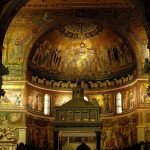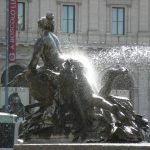Five Fabulous Art Works in Rome You May Have Missed
 For me, deciding on a favorite piece of art in Italy is similar to picking a favorite child: it changes from day to day. On some days, when thinking about Italy’s great art works, a certain color combo will grab me or maybe a dark mood has me preferring chiaroscuro over lighter fare. At any rate, this month’s Italy Blogging Roundtable topic is favorite work of art in Italy. So, I plan to introduce you to no less than five of my favorites.
For me, deciding on a favorite piece of art in Italy is similar to picking a favorite child: it changes from day to day. On some days, when thinking about Italy’s great art works, a certain color combo will grab me or maybe a dark mood has me preferring chiaroscuro over lighter fare. At any rate, this month’s Italy Blogging Roundtable topic is favorite work of art in Italy. So, I plan to introduce you to no less than five of my favorites.I have further narrowed down my favorites to works in Rome. Rome is not the first Italian city travelers look to for art – that’d be Florence. But Rome has an astounding trove of paintings, sculpture, and mosaics, not even counting the Pieta, Sistine Chapel, and the other usual suspects. With this post, I wanted to introduce some of the art works in Rome that I find particularly compelling, the pieces that I try to fit in a view of each time I’m in the Eternal City because they “speak to me.” Perhaps you will not find the same beauty or feeling in the five art works I’m listing below. So it’s up to you, on your next trip to Italy, to keep your eyes open for that one piece of art that makes your heart sing.
Five Fabulous Art Works in Rome You May Have Missed
 Niccoline Chapel. Tucked into the oldest part of the Vatican, the Niccoline Chapel, or Cappella Nicolina, has been my little slice of heaven since I was introduced to it in Art History class years ago. This tiny chapel was decorated for Pope Nicholas V with frescoes by Fra Angelico, an early Renaissance painter from Florence, and his assistants. What mesmerizes me about the Cappella Nicolina is its tiny jewel box quality. Gold leaf is used to highlight clothing and architecture in the scenes depicting the lives of St. Stephen and St. Laurence, and gold dabs on the vaulted ceiling simulate, in my mind, an early planetarium. If you’re not a part of a large group, you can usually linger a while behind the cordon of the Cappella Nicolina, soaking in the deep blues and golds and pastels of the frescoes while others shuffle off in search of that better known chapel in the Vatican Museums.
Niccoline Chapel. Tucked into the oldest part of the Vatican, the Niccoline Chapel, or Cappella Nicolina, has been my little slice of heaven since I was introduced to it in Art History class years ago. This tiny chapel was decorated for Pope Nicholas V with frescoes by Fra Angelico, an early Renaissance painter from Florence, and his assistants. What mesmerizes me about the Cappella Nicolina is its tiny jewel box quality. Gold leaf is used to highlight clothing and architecture in the scenes depicting the lives of St. Stephen and St. Laurence, and gold dabs on the vaulted ceiling simulate, in my mind, an early planetarium. If you’re not a part of a large group, you can usually linger a while behind the cordon of the Cappella Nicolina, soaking in the deep blues and golds and pastels of the frescoes while others shuffle off in search of that better known chapel in the Vatican Museums. Raphael’s “Triumph of Galatea” is another eye-pleasing work by a Renaissance master that doesn’t get the foot traffic it deserves. And thank God for that. While I am very fond of Raphael and his superb “School of Athens” in the Vatican, I love taking a detour to the Villa Farnesina in Trastevere. This quiet former palace of both the Chigi and Farnese families now houses a science academy and a municipal print room, but it also contains several decorated rooms open to the public. With its mythological theme, “Galatea” greatly resembles Sandro Botticelli’s “Birth of Venus” (quite possibly my favorite piece of work ever, but I just couldn’t come right out and be that obvious). But I think what appeals to me most about this Raphael work is that you can visit it in almost complete silence, which, for me, enhances the beauty of the work enormously.
Raphael’s “Triumph of Galatea” is another eye-pleasing work by a Renaissance master that doesn’t get the foot traffic it deserves. And thank God for that. While I am very fond of Raphael and his superb “School of Athens” in the Vatican, I love taking a detour to the Villa Farnesina in Trastevere. This quiet former palace of both the Chigi and Farnese families now houses a science academy and a municipal print room, but it also contains several decorated rooms open to the public. With its mythological theme, “Galatea” greatly resembles Sandro Botticelli’s “Birth of Venus” (quite possibly my favorite piece of work ever, but I just couldn’t come right out and be that obvious). But I think what appeals to me most about this Raphael work is that you can visit it in almost complete silence, which, for me, enhances the beauty of the work enormously. Apse mosaics in Santa Maria in Trastevere. I cannot go to Rome and not see the church of Santa Maria in Trastevere. I am, quite simply, mesmerized by mosaics, and this church has them inside and out. While I can sit on the steps of the central fountain in the adjacent square, staring at the church’s facade mosaics, it is the tile work in Santa Maria’s apse that gets me every time. Thousands of golden and other richly-colored tiles, here depicting the Coronation of the Virgin, create that glowing, heavenly aura that could turn almost any non-believer devout. Santa Maria in Trastevere does not have the best mosaics in Italy (check out Ravenna for that), but it does have the best in Rome.
Apse mosaics in Santa Maria in Trastevere. I cannot go to Rome and not see the church of Santa Maria in Trastevere. I am, quite simply, mesmerized by mosaics, and this church has them inside and out. While I can sit on the steps of the central fountain in the adjacent square, staring at the church’s facade mosaics, it is the tile work in Santa Maria’s apse that gets me every time. Thousands of golden and other richly-colored tiles, here depicting the Coronation of the Virgin, create that glowing, heavenly aura that could turn almost any non-believer devout. Santa Maria in Trastevere does not have the best mosaics in Italy (check out Ravenna for that), but it does have the best in Rome. Bernini’s Apollo and Daphne. Anyone paying attention while on a tour of Rome will notice that Bernini is the main artistic star of the city. His Baroque-era fountains, sculptures, and paintings can be found in nearly every corner, but, for the average tourist, his name doesn’t have the same star power as, say, a Michelangelo or a Raphael. Nevertheless, his sculpture of “Apollo and Daphne” in the Galleria Borghese is not to be overlooked. After the first live look at the creamy marble bodies, human-like expressions, and expertly carved details, such as the dimples and folds of the couples’ skin, I resolved to learn all that I could about Bernini. What I learned is that this particular piece of sculpture is worth multiple visits.
Bernini’s Apollo and Daphne. Anyone paying attention while on a tour of Rome will notice that Bernini is the main artistic star of the city. His Baroque-era fountains, sculptures, and paintings can be found in nearly every corner, but, for the average tourist, his name doesn’t have the same star power as, say, a Michelangelo or a Raphael. Nevertheless, his sculpture of “Apollo and Daphne” in the Galleria Borghese is not to be overlooked. After the first live look at the creamy marble bodies, human-like expressions, and expertly carved details, such as the dimples and folds of the couples’ skin, I resolved to learn all that I could about Bernini. What I learned is that this particular piece of sculpture is worth multiple visits. The Fountain of the Nymphs. For such a fun work of art, the Fontana delle Naiadi (the Fountain of the Nymphs) is in an unfortunate place: smack in the middle of busy Piazza della Repubblica. And yet, I cannot do without seeing this frisky, late 19th/early 20th century fountain each time I’m in the Italian capital. The Naiads Fountain is far from being the at the top – or even among the Top 100 – of the city’s attractions. But I always smile when observing the playfulness of piece and how it exists as a fixture of the everyday in the living city that is Rome. The Fontana delle Naiadi reminds me a trip to Rome need not be so serious and that its beauty isn’t limited to any era.
The Fountain of the Nymphs. For such a fun work of art, the Fontana delle Naiadi (the Fountain of the Nymphs) is in an unfortunate place: smack in the middle of busy Piazza della Repubblica. And yet, I cannot do without seeing this frisky, late 19th/early 20th century fountain each time I’m in the Italian capital. The Naiads Fountain is far from being the at the top – or even among the Top 100 – of the city’s attractions. But I always smile when observing the playfulness of piece and how it exists as a fixture of the everyday in the living city that is Rome. The Fontana delle Naiadi reminds me a trip to Rome need not be so serious and that its beauty isn’t limited to any era.Read the posts, leave comments, share them with your friends – and tune in next month for another Italy Blogging Roundtable topic.
No comments:
Post a Comment